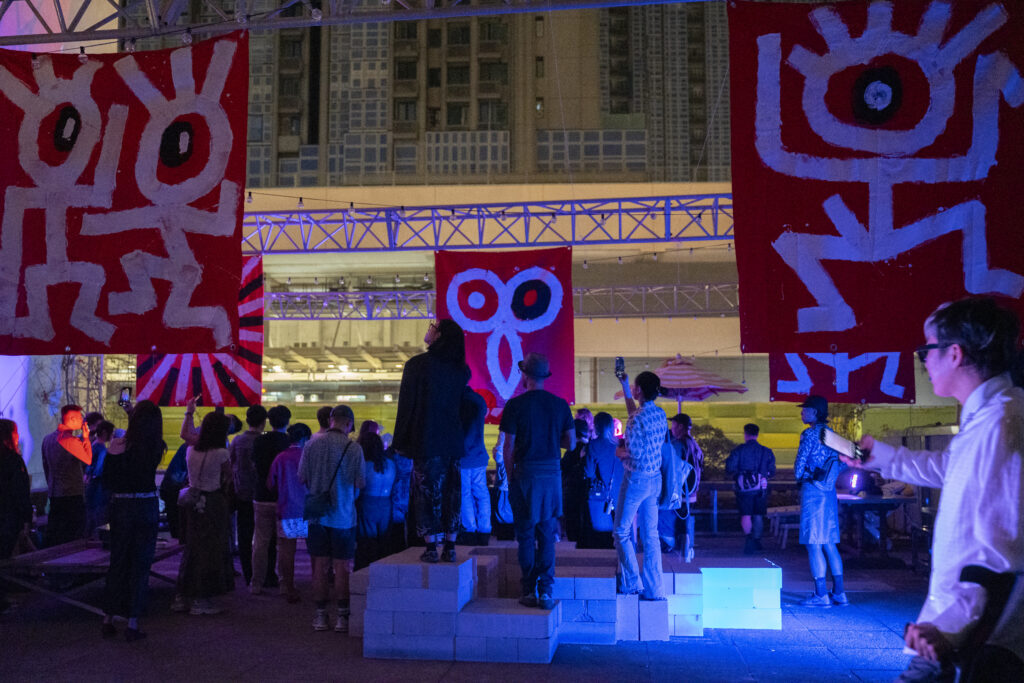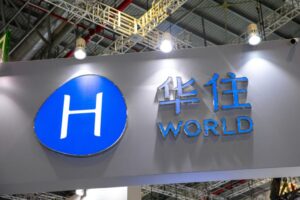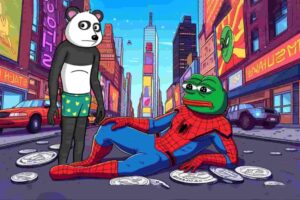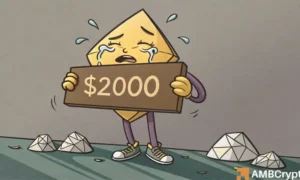
Despite Hong Kong still grappling with political and economic uncertainties, the city was bustling with energy during this year’s art week, driven by a nonstop schedule of events hosted by both local institutions and regional players—proof of the dynamism fueling its fast-evolving art scene. While pre-pandemic iterations of Hong Kong Art Week were largely defined by international galleries staging parties and satellite events, the city now feels more self-possessed, having cultivated a vibrant and increasingly sophisticated local scene that thrives across new experimental spaces, pioneering artistic practices and a resilient creative ecosystem that stretches across disciplines and borders.
That momentum was palpable from the very first events on Monday, beginning with a lavishly attended cocktail reception at the Peninsula for “Artists in Resonance,” the hotel’s public art program. The night continued with a buzzing reception at the Carlyle at Rosewood to launch Dib Bangkok, Thailand’s first private museum for global contemporary art, where the young founders spent the evening onstage playing guitar for their guests rather than touting their already notable collection. The night closed with a packed M+ annual party, where the full breadth of Hong Kong’s creative community came into view through a dense lineup of experimental performances and D.J. sets that kept both local and international audiences energized until late.
Meanwhile, satellite fairs Art Central and Supper Club have continued to grow in exhibitor count and overall quality: around 200 Asian and international galleries chose to be part of Hong Kong’s art week this year through these alternative platforms, which offer more accessible formats and price points without sacrificing ambition or depth.


The hybrid art event Supper Club opened ahead of Art Basel Hong Kong on an already packed day in Central, where multiple galleries held their receptions simultaneously. Launched during last year’s art week as an alternative project—a night event blurring the line between opening and party—Supper Club has swiftly evolved into a full-fledged fair, now hosted inside the H Queen’s building in Central, where David Zwirner and Pace also have their spaces. Backed by enthusiastic support from both regional collectors and international exhibitors, Supper has grown quickly from a casual late-night gathering into a serious contender for attention on the busy fair circuit.
Its open-plan layout across two floors offers a refreshing contrast to the traditional booth model, inviting more fluid interaction among exhibitors and encouraging spontaneous exchanges with visitors. The success of this open format hinges on thoughtful curation, and Supper delivered in 2025. The curatorial team carefully selected and positioned galleries and artists who resonated with each other in a very organic way.
“I’m thrilled with the reception of the second edition of the Supper Club. Alternatives like these are so important, and it’s wonderful to see so many collectors and curators supporting galleries as we self-organize and shake things up,” said Willem Molesworth, who co-founded the fair with his partner Ysabelle Cheung (with whom he also runs the cutting-edge gallery PHD Group) and Alex Chan of THE SHOPHOUSE. “Our new venue is incredible and brings a wonderful atmosphere and energy to the project. I’m delighted we could make it happen again, and I look forward to the next one.”


Among the exhibitors was the Seoul-based experimental gallery Cylinder, which presented a tightly curated one-wall display featuring a constellation of small and medium-sized paintings by Sunwon Chang, Minseo Kang, Minhee Kim, Seo Hyun Kim and Byeori Yang. The gallery’s founder, Dooyong Ro, was pleased with the outcome, having sold out all of Minseo Kang’s paintings and placed several additional works by the weekend. Last year, Cylinder participated in the inaugural edition of Supper Club, held at Fringe Club, one of Hong Kong’s heritage venues, in a format that leaned more toward alternative event than commercial fair. “The vibe was more lively having the bar inside, easy access to the venue etc.,” Ro told Observer. While he preferred last year’s setting for its atmosphere, he acknowledged that this year’s location served a different purpose. “H Queen’s has attracted more traffic, so, in terms of audience, this year’s edition got more attention. And it is still easy to find the venue—especially for the Korean people who have no idea about Fringe Club.”
Paris-based gallery Sultana presented works by Justin Fitzpatrick and Jean Claracq, marking the first time Claracq’s Monumenta series has been shown in Asia—a body of work also acquired by the Louvre-Lens. “The work has been well appreciated for its institutional-level significance,” says Kate Park, the gallery’s director for sales and business development for Asia, told Observer. Despite the high level of interest, however, Park acknowledged that negotiations were unfolding slowly, and it would take time to close deals.


With a clear focus on more experimental art and ambitious works, this year’s edition of Supper Club was further enriched by a robust program of performances. Among them was Sipping Dreams, an artsy cocktail performance conceived by artist Doreen Chan and hosted by Delfina Foundation on the opening day. Guests were invited to complete a short survey about their dream activity and then served a custom drink tailored to their response.
This year’s overarching concept was curated by director and curator Jims Lam, who previously held positions at Blindspot Gallery, Tai Kwun and Para Site. Building on the strong East Asian presence in the inaugural edition, Lam proudly noted that this year’s iteration expanded the geographic scope. “We are the fair that has been able to include in this edition a number of galleries from Taipei, along with new voices from Sydney in the Southern hemisphere,” he told Observer. He pointed to an increased European presence, particularly from Western Europe. “Hong Kong stands as a dynamic hub for both established artists and newcomers, creating an inclusive space for diverse voices and innovative ideas.” Supper Club exhibitors and its audience, he added, provide a comprehensive view of the global art landscape.
True to its hybrid identity, Supper Club was organized not only as a fair but as a party—an alternative model designed to offer a more relaxed and engaging way to encounter art. The event was intentionally curated to appeal to a younger audience, with exhibitors tailoring their presentations to align with that aim. On Tuesday, the fair was packed despite the competing calendar of parties and gallery dinners that evening, including the highly anticipated White Cube party at Soho House.


Art Central, on the other hand, has been a fixture in Hong Kong since 2015, but the fair’s tenth edition appeared to mark a step forward, attracting a stronger roster of galleries. Several dealers—particularly from the region and the nearby Middle East—joined this year’s lineup, adding new depth to the fair’s characteristically more pop-forward aesthetic. “We are delighted to have opened our milestone tenth edition with exceptional VIP attendance, a marked increase from last year,” director Corey Andrew Barr told Observer. “Galleries reported positive outcomes in both sales and connections with collectors and institutional representatives from Asia, Europe and North America, including those making their first trip to the Fair.”
Among those participating was Cub_ism_ Artspace from Shanghai, which presented a solo booth of paintings by emerging Chinese artist Zheng Lanxiong. His work explores the emotional bond between the individual and the image as a point of entry into a process of creation and co-creation. Isolated fragments of ordinary life, embedded with intimate symbolism, evoke a sense of longing and nostalgia for lost moments of innocence, while smaller paintings enclosed within mnemonic objects function as short-term time capsules designed to guard against the inevitable erosion of memory. With prices all under $10,000, the gallery placed several works on the fair’s opening day, and Barr was optimistic about the prospect of further sales on the weekend, with a few pieces already on hold.


While Art Central continues to lean into youth culture and a more accessible visual language, a handful of presentations this year favored conceptual and research-driven practices. Among them, Dubai-based Rarares gallery offered a striking installation: a full wall of vintage televisions activated by digital animations of sea creatures created by Turkish artist Eegun, shown alongside hybrid, multi-layered blown glass sculptures by Russian-born, Denmark-based artist Maria Koshenkova.
Just a few steps away, Shankay—a gallery and residency program based in Porto and Dubai—unveiled a fully conceptual installation by Eduardo Enrique. Black wooden baseball bats arranged in a ritualistic circle on the floor were echoed by a single bat mounted on the wall in the shape of a provocatively symbolic cross. Nearby, two word-based conceptual paintings extended the work’s underground and subversive aesthetic. Each of the hand-crafted bats was available for $850 and could be acquired individually in any configuration.


Meanwhile, a new neon-green publication quietly made its debut across various venues during art week. Co-produced with Asia Pacific and edited by Benjamin Cha and Tobias Berger (former director at Tai Kwun), Cong is a sleek, exclusive annual journal that promises to investigate and expose the most compelling creative expressions emerging from Hong Kong and the broader Asia Pacific region. Its scope spans overlapping interests in contemporary art, culture, place-making and philosophy. While full details have yet to be released, those behind the project told Observer this first issue marks the beginning of a larger initiative that will culminate later this year in a new hybrid, cross-disciplinary space expected to reshape the city’s creative landscape.
One of the week’s most vigorous demonstrations of Hong Kong’s artistic vitality was at Current Plans, an experimental space that staged a packed program of performances, D.J. sets, exhibitions and activations. Housed in a large industrial space on the rapidly transforming South Side, Current Plans has emerged as a platform dedicated to fostering creative experimentation across disciplines, promoting knowledge exchange and encouraging playful, boundary-pushing approaches to exhibition-making.


In between mesmerizing performances and hypnotic D.J. sets, Eunice Tsang, the founder and main curator of the space, told Observer that, “Everything started a few years back from the idea that we really needed a more experimental DIY artist-run space to fill some gaps in the art ecology of Hong Kong.” Tsang, who also serves as an associate curator at M+, explains that Hong Kong’s art scene, while intimate, remains significantly fractured across its many subcultures and disciplines. “We didn’t have a space where all different creatives could come together equally,” she added. This lack of convergence was the driving force behind launching a space with a multidisciplinary ethos. “Exhibition-making, in that sense, becomes just a pretext to bring together people from different creative disciplines in a space where they can share ideas.”
Driven by this collaborative, cross-disciplinary spirit, the underground programming curated by Current Plans during art week brought together a visionary, intergenerational group of artists and musicians from Hong Kong, Shanghai, Hangzhou and neighboring countries, including South Korea, Japan and Indonesia.


This week’s multilayered, cross-category project at Current Plans—an intense condensation of the space’s hybrid ethos—kicked off on Tuesday with an evening organized in collaboration with Hangzhou-based collective Martin Goya Business and the art media platform C for ABC. Titled “No Rest For the Wicked,” the event featured an eccentric, genre-defying mix of performance and presentation. One of the highlights was a bewildering piece oscillating between dystopian imagery and societal critique by cross-media artist xiexie3lla (Ella Wang Olsson), which accompanied the launch of a book and short film by Mian, a legendary figure from Shanghai’s early club and subculture scene. Interwoven throughout was an experimental noise performance that created an immersive, synesthetic blend of visuals and sound.
SEE ALSO: The Must-See Exhibitions Opening During Art Basel Hong Kong
Continuing the week’s deep engagement with the intersection of music and art, Wednesday brought a sonic exploration by artists-in-residence Ye Hui (Vienna/GZ) and Wahono (Jakarta). On Thursday, the program took on a more chaotic, ecstatic tone with a hybrid rave/experimental performance curated by the duo Panic Library and Seoul’s Cake Shop and supported by the Rockbund Museum in Shanghai, the new foundation Cheruby founded by young Chinese patron Cherry Xu and 99 Canal in New York.
“Our vision since the beginning has always centered around three things: to be fluid, to be generous and to be disruptive,” Tsang said, emphasizing that fluidity means embracing the fact that everything and everyone is always in flux. “We have to be able to present the urgent and the very contemporary,” she added. “We have to be able to respond to whatever is happening socially and politically in Hong Kong.” For Tsang and the team at Current Plans, generosity means fostering a spontaneous exchange of knowledge across media and disciplines. But disruption, she says, may be the most essential element of all. “I believe in this quote: ‘Art should be comforting for the disturbed and disturb the comfortable.’”


In an evolving arts ecosystem like Hong Kong—where the cultural landscape is continually shaped by the push and pull of politics, economic forces, censorship and gentrification—Current Plans has established a rare platform where artists, creatives and musicians gather, exchange ideas and confront shared concerns. “We are a sort of enclave, where people can have fun and be free to experiment,” Tsang said, reflecting on how the everyday reality of art-making under societal pressure—particularly in a fast-paced, high-stakes city like Hong Kong—can sometimes feel devoid of humor and joy. “It’s an explosion of parties and fun over Art Basel week, but the rest of the time, everything is so serious here. I believe we need a laugh and fun to create new questions and ideas instead. Exhibitions and art-making should have some humor in them. That’s why Current Plans is kind of a chaotic community.”
A chaotic, yet deeply fertile community—one that fosters the creative energy that might otherwise be stifled in a city of this scale. Against expectations and despite ongoing pressures, Hong Kong’s art scene was on full display this week, revealing the strength of a dynamic new generation of creatives working together to build something lasting for the city and the wider region.




